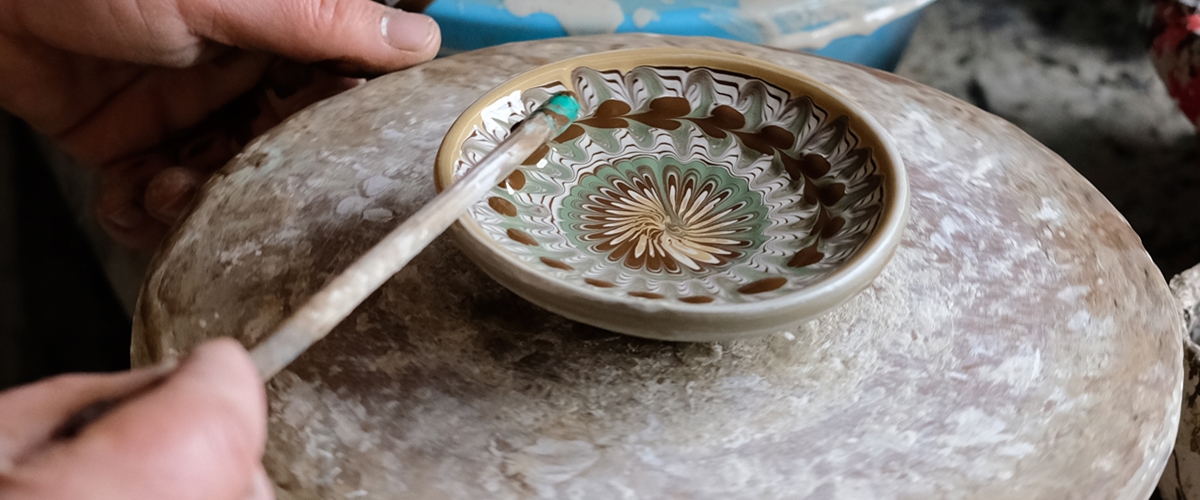The romanian pottery
Since the beginning, ceramics in the Romanian region has shown itself not only as a craft created to satisfy needs (obtaining clay vessels used in daily life), but also as an art form, a component of a very old civilization, in which the utilitarian aspect was associated with a unique visual understanding.
In order to produce beautiful pottery, men and women share knowledge this craft down the generations. Clay, earthy minerals, water, and other naturally existing raw materials are combined to create pottery, it is then moulded into shapes. The clay body is moulded, then heated at a high temperature in a kiln to harden and make it heat resistant.
Pottery has been a typical occupation since the Neolithic era (5000–6000 years ago), developing over time into a culture with various components related to shape, colours, and decorative motifs depending on the areas and the destination of the objects: ritual vessels (dedicated to religious celebrations or important life events such as weddings, births, and funerals), decorative vessels for the peasant household, and vessels used for practical purposes such as toys, musical instruments (ocarinas, whistles), architectural elements, jugs, mugs, pots, candlesticks, etc.
Romania has a number of significant pottery centres, making it one of the few nations with unique traditional crafts. The most well-known pottery-producing villages are Horezu, Marginea and Corund.
Horezu pottery (Valcea County), which is also the result of a long history, can be recognised by the decorative motifs including the rooster, the snake, the spiral, the fish, the dove, the star, the sun, and the tree of life together with the chosen colours of green, blue, and brick on a white or yellowish background.
Potters in Marginea (Suceava County) continue to utilise ancient techniques to create black pottery (strachini, pots with or without kilns), with the black colour obtained through a firing procedure in closed kilns. Simple, geometric, or vegetal accents, including fir branches, clover, or vines, serve as decorations.
The village of Corund, also known as Korond in Hungarian, is one of the most significant pottery centres in all of Europe. The potters of Corund, situated in the county of Harghita, stayed faithful to the shades of white, blue, and brown. Corund has a proverb that says:” Pottery has always been produced ever since the world existed.” The main items include pots, pans, butter presses, jars, filters, cups, candle stands, salt cellars, and ornamental plates (with chessboards, peafowl eyes, pine branches, edelweiss, spinning cases, life trees, grids, doorposts, tulips, half-suns, peafowls, chrysanthemums, oak leaves, and thread). Many countries import the Corund pottery.
One of the most famous Romanian potters is Daniel Leș (from Baia Sprie, Maramureș).Daniel Leș respects the virtues of a simple existence, such as authenticity and inner serenity. He lives in Maramureş, one of Romania's most beautiful regions. Pottery, drawing, painting, and ceramic modelling were all skills he learned from his father, the painter and potter Ioan Leș.
He built his own studio more than 20 years ago and utilises time-honored methods that have been in use since Dacian times, using only clay, water, and fire. Daniel is a master of the figurative ceramics style, and many international exhibitions and museums have presented his works.
Therefore, if you are in Romania and you love the traditional world, do not forget that you can learn from talented instructors how to personalise a ceramic vessel with imprints and colours, then send the finished product for glazing. If you want to use the plate you made for eating or give a mug you painted and crafted as a gift, consider participate in a ceramic workshop. You can enrol in the pottery classes offered by the most skilled potters.
Black Pottery Center With 200 Years History: Marginea
MARGINEA’S BLACK CERAMICS
In a village in Bucovina, called Marginea, a hidden treasure is found in the hands of the potters. The treasure is their skill in creating black ceramic vessels of extraordinary beauty. The craft of creating these vessels is special and not found very often.
The legend says that the Marginea’s Black Ceramics is due to a Dac potter whose oven was broken while he had ceramic vessels, fired, inside it. Due to the high temperature the potter could not approach the oven and left it to cool overnight.
In the morning he went to the oven and all the dishes were black due to the smoke that had entered the pores of the dishes, resulting in particularly beautiful black dishes.
Since then, potters have used this method to obtain black pottery.
The black ceramics from Marginea, unique in Romania, made the name of the locality known all over the world. The craft of black ceramics is a special art. If in Europe there are still a few areas where black ceramics are worked, in Romania, the tradition is preserved only in Marginea.
In Marginea, in the old days, there were 60 families who worked with pottery. Now there are only three left. And in the whole area you can find only one workshop.
A foray into Marginea cannot be completed without a stop at one of the few pottery workshops in the area open for visits.






.png)



